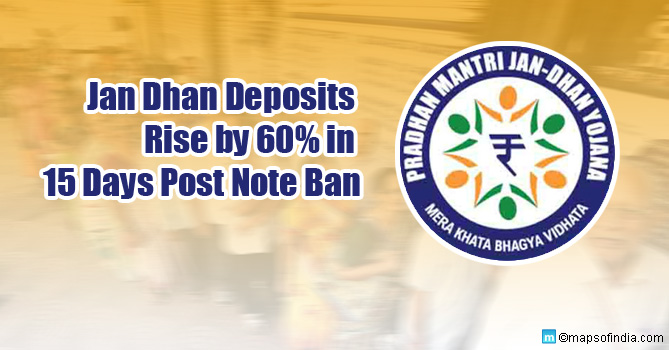Prime Minister Narendra Modi’s move of demonetisation of Rs 500 and Rs 1000 currency notes has resulted in a surge of the total balance of the Jan Dhan accounts under the Pradhan Mantri Jan Dhan Yojana (PMJDY). As per an online data update, the total balance in the Jan Dhan accounts have increased by 60%. While the accounts stood at Rs 45,637 crore on November 9, 2016, a day after demonetisation was announced; it rose to Rs 72,835 crore on November 23, 2016 — an increase of Rs 27,198 crore in two weeks.
- In the first week after demonetisation, the total balance in Jan Dhan accounts went up by Rs 18,615 crore, which is 60 times the weekly average of 311 crore since March 31st, 2016.
- In the second week, the deposits became a little lesser at Rs 8,582 crore, but it was still 27 times the weekly average.
- 16.47 lakh new Jan Dhan accounts have been opened in these two weeks.
- There has been a 0.33 percent drop in the total number of accounts with zero balance.
- As per survey, while there were small deposits in accounts in some areas after the note ban, other regions noticed sudden influx of huge cash deposits. The latter, however, will now come under increased scrutiny.
At the moment, the balance under the PMJDY stands at a staggering amount of Rs 2,836.63 crore as against Rs 1,697-1,799 in this financial year since April. While the increase in balance in accounts in public sector banks was 56 per cent, it stood at 66 per cent in private sector banks. The regional rural banks saw the maximum surge with the balance increasing by as much as 77 per cent.
UP saw the maximum increase in the Jan Dhan accounts with a rise of Rs 4,287.55 crore followed by Rajasthan at Rs 2,574.85 crore, West Bengal at Rs 2,553.85 crore, Punjab at Rs 936.73 crore, and Goa at Rs 31.06 crore. Interestingly, all these states are poll-bound states.
A Recap on PMJDY
Pradhan Mantri Jan-Dhan Yojana (PMJDY) was introduced by Prime Minister Narendra Modi as a part of a National Mission for Financial Inclusion of the poorest of the poor in India, to ensure their access to financial services, namely, Banking/ Savings & Deposit Accounts, Remittance, Credit, Insurance, Pension in an affordable manner. PMJDY has the following features when seen in relation to demonetisation:
- An account can be opened in any bank branch or Business Correspondent (Bank Mitr) outlet with a ‘Zero’ balance.
- A minimum balance is required only if the account-holder wishes to get a cheque book.
- Aadhaar Card/Aadhaar Number is enough for opening a Jan Dhan account, and a self certification of current address is sufficient.
- In case of unavailability of Aadhar card, Voter ID Card, Driving License, PAN Card, Passport & NREGA Card can be used for opening an account.
- If a person does not have any of the officially valid documents mentioned above, identity card with applicant’s photograph issued by Central/State Government Departments, Statutory/Regulatory Authorities, Public Sector Undertakings, Scheduled Commercial Banks and Public Financial Institutions can also be used to open a Jan Dhan account.
- In case of absence of any such official document, an individual can still open an account valid up to 12 months, known as the Small Account, or Chota Khata PMJDY, with just two self-attested photographs.
- The Small Accounts can have a maximum of Rs 50,000 deposit and a withdrawal of up to Rs. 10,000 a month.
- Jan Dhan accounts have the facility of easy transfer of money across India.
Demonetisation & PMJDY – How are they related
The objective of demonetisation was to flush out the rich with unaccounted money. But it seems that it has had other repercussions. It has made the poor rich with the new concept of Benami Deposits. The accounts of the poorest of the poor are now swelling with cash. After all India has 22% population at the Below Poverty Level, who are now being used as mules by the rich with black money. It is but obvious that the poor are being made to open Jan Dhan accounts and cash is being ingested into these accounts.
Now, whether the cash ingested is going to belong to the poor, or they will just be given a small percentage on withdrawal is the biggest question. In all probabilities, most of the money deposited once withdrawn will be taken back by the black money launderers, and this time as legit white money. The poor are just being used by the black money holders to park their funds, and sudden deposits into accounts that have been lying defunct for the last 2 years is the proof to this fact.
However, the Government will surely flush out the black money launderers through a data-centric environment. All the black money that has found its way into the banking system will be traceable now. Though this will involve tremendous data mining, the government through a check kept on withdrawals will be able to trace the source of income and deposit. While the black money launderers continue to find loopholes in the system, they have only a 51-day window to convert their black money to white.
It is also up to the poor who are being used as mules. Will they help the government, or will they in return for a measly sum of money help the rich with unaccounted money stay rich. As a last resort, the government may have to hold the poor to ransom to flush out the black money holders.
Related Articles…
What will the RBI do with the old currency notes?
Jan Dhan Yojna – BC Scheme and Financial Literacy Can Help
Pradhan Mantri Suraksha Bima Yojana (PMSBY) – An accidental insurance scheme
Pradhan Mantri Jeevan Jyoti Bima Yojana (PMJJBY): Ensuring your Future
Jan Dhan Yojana – An Era Of Financial Inclusion Begins
Jan Dhan Yojana Target Achieved, But Benefits Still Elusive
Jan Dhan Yojna a Big Hit, But Why Account Transactions Are Nil!
Jan Dhan Yojana Progress and the Roadblocks
Jan Dhan Yojna Concern Over Multiple Accounts
Pradhan Mantri Nai Manzil Scheme Yojana






